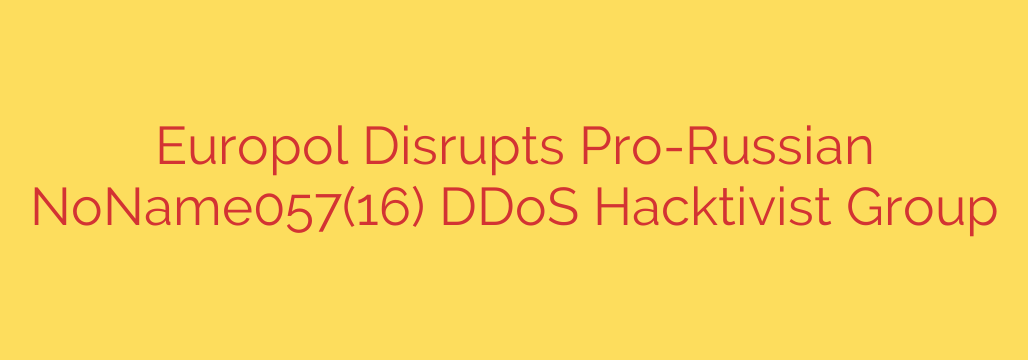
International Police Action Cripples Pro-Russian DDoS Hacktivist Group
In a significant move against politically motivated cybercrime, an international law enforcement operation has successfully disrupted the infrastructure of the notorious pro-Russian hacktivist group known as NoName057(16). The coordinated effort, dubbed “Operation Power Off,” marks a major victory in the ongoing battle against threat actors targeting nations that support Ukraine.
Led by Europol’s European Cybercrime Centre (EC3), the operation involved close collaboration between police forces in Denmark, Germany, Finland, and the National Police of Ukraine. This joint action targeted the very heart of the hacktivist group’s ability to launch disruptive cyberattacks.
Who is NoName057(16)? A Look at a Notorious Threat Actor
Active since the start of the full-scale Russian invasion of Ukraine in 2022, NoName057(16) has built a reputation for its relentless Distributed Denial-of-Service (DDoS) attacks. These attacks are designed to overwhelm websites and online services with a flood of malicious traffic, rendering them inaccessible to legitimate users.
The group’s targets have consistently been governments, critical infrastructure operators, and private companies in countries perceived as hostile to Russian interests. Their attacks, while not typically leading to data theft, are designed to cause disruption, sow chaos, and broadcast a political message.
“Operation Power Off”: A Decisive Blow to Command Infrastructure
The core success of “Operation Power Off” was the seizure of key command-and-control (C2) servers used by NoName057(16). These servers were essential for coordinating their botnet and directing attacks against designated targets. By taking these servers offline, law enforcement has severely hampered the group’s operational capabilities.
The investigation didn’t stop at digital infrastructure. In a critical development, Ukrainian authorities successfully identified a key figure within the group, who was subsequently questioned by the National Police. This demonstrates a multi-pronged approach that targets both the tools and the people behind these cyberattacks.
The Modus Operandi: How the Group Launched Its Attacks
NoName057(16) employed a common but effective hacktivist model. They operated a botnet of infected computers, often leveraging their custom software tool called “DDoSia.” This tool was made available to volunteers and sympathizers who wanted to participate in the attacks.
Uniquely, the group also offered financial rewards to its most active participants, paying them in cryptocurrency for contributing their computing resources to the DDoS campaigns. This incentive structure helped them maintain a large and motivated pool of volunteers to carry out their disruptive agenda.
While the group remains active on platforms like Telegram, this operation represents a significant setback to their ability to launch large-scale, coordinated attacks. The disruption of their primary infrastructure forces them to rebuild, a process that is both time-consuming and challenging under the watchful eye of international law enforcement.
How to Protect Your Organization from DDoS Attacks
This operation highlights the persistent threat of DDoS attacks, especially for organizations involved in politically sensitive sectors. It is crucial to have robust defenses in place. Here are several actionable steps to enhance your security posture:
- Implement a DDoS Mitigation Service: Partner with a specialized provider (like Cloudflare, Akamai, or AWS Shield) that can absorb and filter malicious traffic before it reaches your network. This is the single most effective defense.
- Maintain a Strong Network Infrastructure: Ensure your firewalls, routers, and load balancers are properly configured and updated to handle traffic spikes and filter out basic attack patterns.
- Develop an Incident Response Plan: Know exactly what to do when an attack occurs. Your plan should define roles, communication strategies, and the technical steps required to mitigate the attack and restore services quickly.
- Utilize a Web Application Firewall (WAF): A WAF can help filter out malicious application-layer requests that are often part of a sophisticated DDoS attack, providing an additional layer of protection.
- Monitor Network Traffic: Proactively monitor your traffic for unusual patterns or sudden surges. Early detection can give your team more time to react and enable mitigation measures before a full-blown outage occurs.
Source: https://www.bleepingcomputer.com/news/security/europol-disrupts-pro-russian-noname05716-ddos-hacktivist-group/








